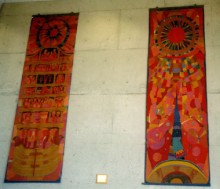Saul Borisov
Saul Borisov (1912-1991) spent his early childhood in a town that he would eventually take as his namesake: Borisov, Russia, near Minsk in present-day Belarus. In 1923 his family immigrated to New York City, where he studied painting at the Cooper Union School of Art. In 1948 Borisov moved to Mexico City, where he discovered weaving—a medium that would be his focus for the rest of his life.
Borisov mastered local practices of traditional weaving quickly, and launched a series of experiments in technique. Unlike contemporary weavers like Gunta Stolzl and Annie Albers, whose work relied on a harmonious, somewhat rigid relationship to form and material, Borisov was passionately improvisational. He fought the loom, pushing it to create tapestries that it didn't want to make—pieces with curves, odd-shaped gaps and slits with asymmetrical compositions. He dyed all of the material himself, using striking colors to create unique forms that range from densely detailed representational work to solid abstract color fields.
Source: https://www.saulborisov.com/
